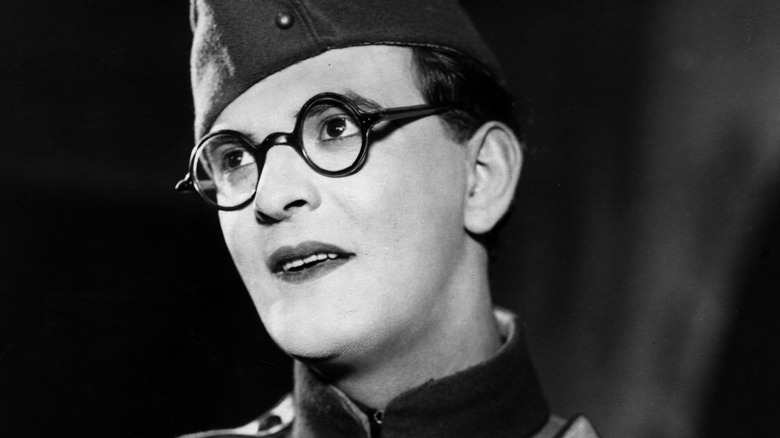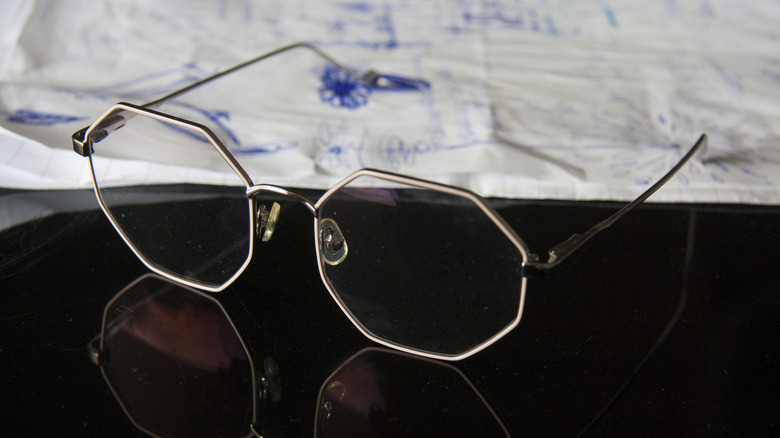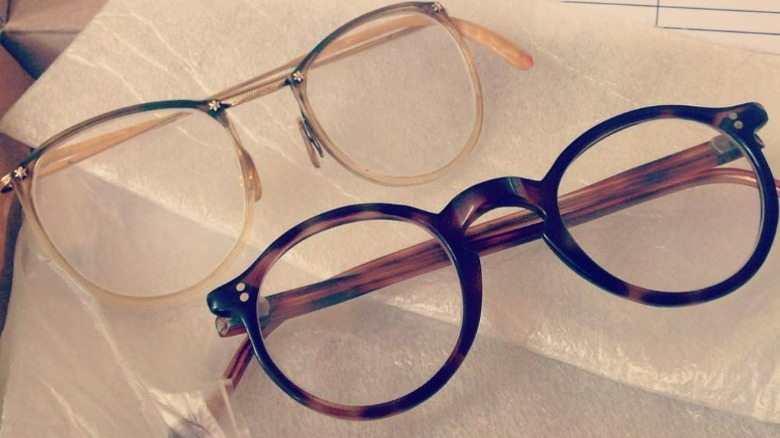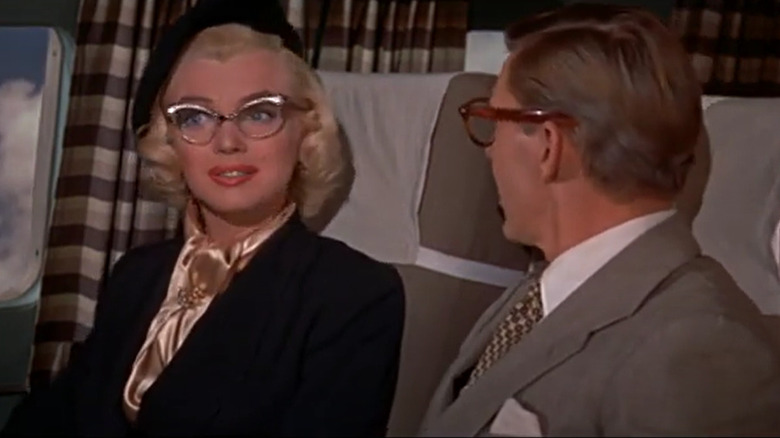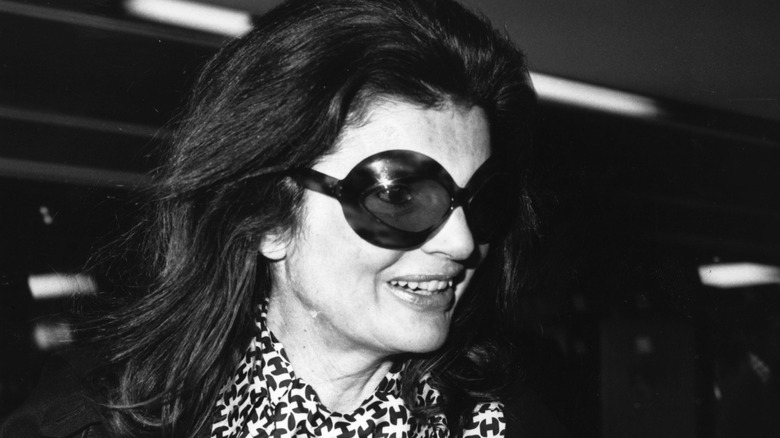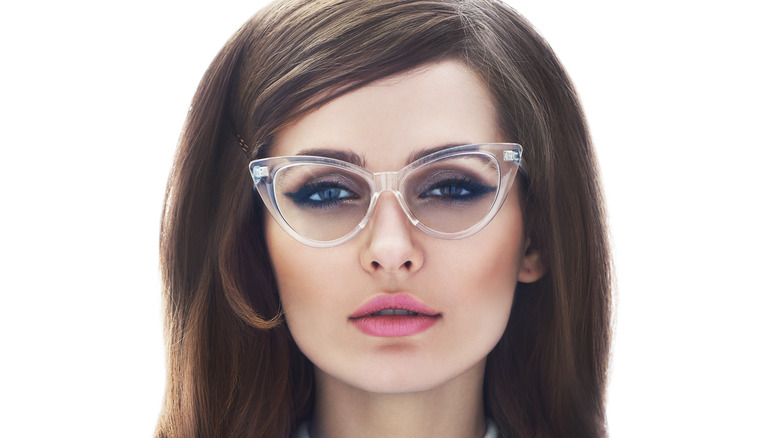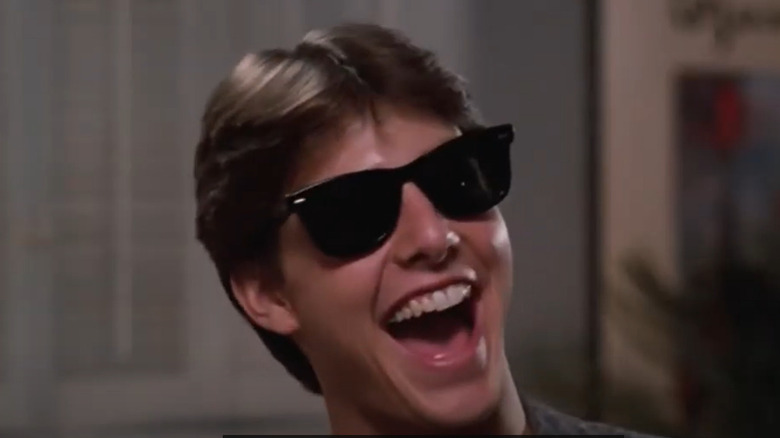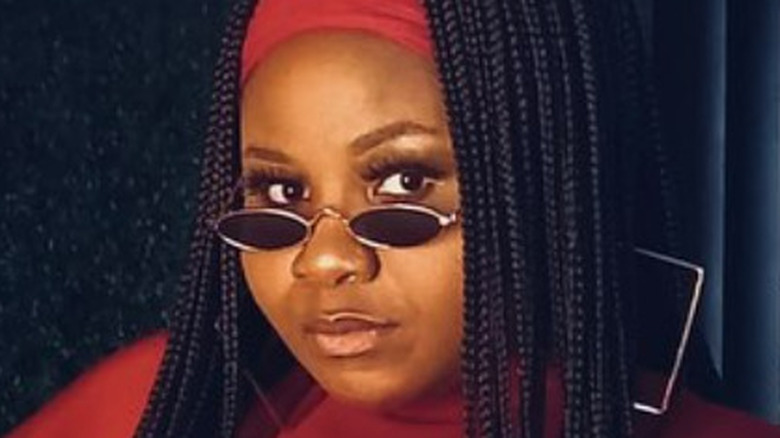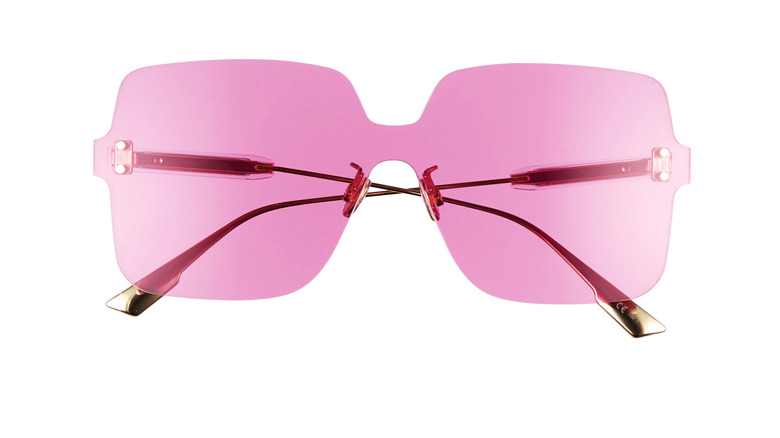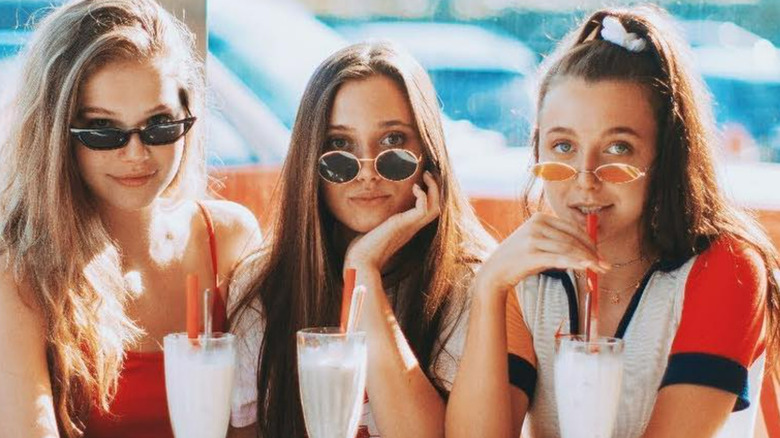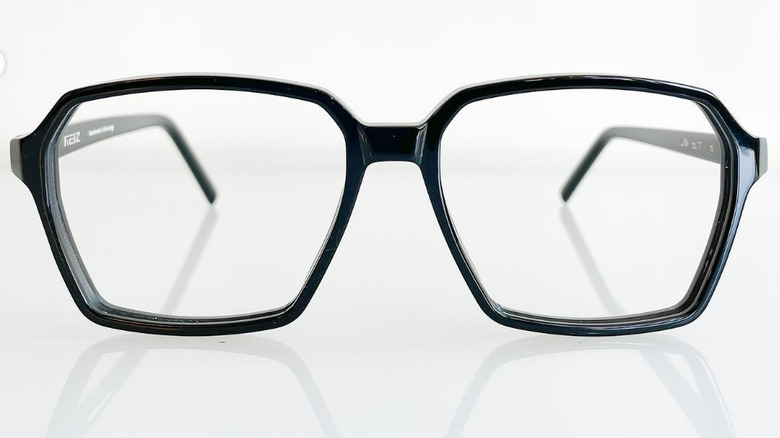100 Years Of Fashion: Glasses
Vision problems are a tale as old as time, but eyeglasses weren't invented until the 13th century (per NPR). Before then, people who had difficulty seeing things up close simply didn't spend much time attempting to do so, and that was completely workable prior to the invention of the printing press in 1750. Nearsighted early humans were at a greater disadvantage, however, because difficulty focusing on distant objects and vistas could prove hazardous to life and limb.
Fortunately, myopia (nearsightedness) was not prevalent prior to the rise of the printed word. On the other hand, eyeglass wearers, few and far between as they were, tended to be perceived as disabled or potentially "in league with the devil," according to Neil Handley, museum curator at the College of Optometrists, London (via NPR).
Nowadays, almost 20% of American adults surveyed by the Vision Council of America cop to wearing glasses for style's sake alone, according to the American Refractive Surgery Council. Indeed, you can actually appear smarter and more professional just by donning a pair, according to research by the College of Optometrists (via Penn State University). You may also appear more approachable and your features more symmetrical. Although glasses may still feel embarrassing to wearers, by the 1900s, they'd become less stigmatized. By the time the Roaring '20s rolled around, glasses were on their way to becoming the fashion statement they are today. Let's have a look!
1920-1929: the spectacle of Hollywood
Nearsightedness has become more common since the turn of the 19th century. Fortunately for the myopic, that timing coincided with industrialization. That made mass production of eyewear a possibility, and so it began in earnest. What did not begin until the turn of the 20th century, however, was the transformation of glasses from merely functional to fun and fashionable. And even then, it was slow-going.
It wasn't until well into the Silent Film age (1894-1929) that eyeglasses actually became a fashion statement. Significant credit is due to Harold Lloyd. The silent film actor and comedian is widely regarded as having pioneered the look that might be called "glasses geek chic." Starting in the late 1910s, Lloyd, whose vision was 20/20, wore smallish, round, black-framed glasses to play a hapless but loveable man-child, whom Lloyd, himself described as "boyish, clean, sympathetic, [and] not impossible to romance" (via Harold Lloyd).
Throughout the 1920s, glasses looked much like Lloyd's — not just because the actor had popularized the look, but also because the affordable mass market choices were limited. Nevertheless, as the decade proceeded, tortoiseshell frames grew in popularity, while rimless glasses were seen on some who hoped to achieve a more subtle bespectacled look. In addition, nose pads were first introduced during the 1920s, and they were a game-changer. Before that, the nose bridge on glasses had to be designed to hug the nose so the glasses wouldn't fall off. Their invention sparked never-before-seen eyewear styles.
1930-1939: eyeglasses take shape, literally
As glasses grew more common, and their manufacturing more streamlined, the 1930s saw several important developments in eyeglass style. Although round was still popular, a rounded octagonal shape was making headway, possibly the result of a 1931 Life magazine cover featuring an octagon spectacle-wearing, Ernest Weir — a then well-known steel industry tycoon. Octagonal glasses were either rimless, wire-rimmed, or some combination of both.
Metal frames grew in popularity throughout the '30s, as did plastic frames, which were now available as an option and capable of being mass-marketed thanks to technological advances. Plastic frames grew in popularity as a lighter, more affordable alternative to animal horns, shells, and other natural materials, such as the actual tortoiseshells once used in making tortoiseshell frames.
But the biggest glasses innovation to come in the 1930s was purely stylistic: the cat-eye. Iconic artist, entrepreneur, and inventor, Altina Schinasi, patented the cat-eye frame as Harlequin Glasses — presumably owing to its resemblance to a hand-held masquerade party mask. However, the more descriptively generic cat-eye moniker stuck, and the style has only grown in popularity since.
In addition, sunglasses, which became available to the mass market in 1929 via Sam Foster of the still-popular Foster Grant brand, grew into a beach-going staple throughout the 1930s. However, sunglasses were primarily a style choice until 1936, when Edwin H. Land's Polaroid filter spawned the dawn of polarized sunglasses — which actually shielded the eyes from the sun's damaging rays.
1940-1949: plastic frames inspire new fashion choices
World War II began in 1939, and while the U.S. managed to stay out of it until the attack on Pearl Harbor on December 7, 1941, the war's looming presence impacted American fashion. Until the war's end in 1945, many were inclined to stick with frame-shape favorites from previous decades, including round, octagonal, and cat-eye.
Nevertheless, innovations continued to impact the materials that were being used to make the frames. Although wire frames and frames made from natural materials, such as tortoiseshell, remained popular, the advent of plastic frames, which began in the 1930s, was now in full swing. Plastic manufacturing, which had become increasingly common throughout the first half of the 1940s, became, in the second half, commonplace. Among other things, that meant that throughout the 1940s, plastic frames were becoming the more affordable frame option.
Although plastic frames were clunkier than wire, they offered one distinct advantage: Plastic frames could be dyed virtually any color. Although "disappearing" flesh-colored plastic frames proved to be extraordinarily popular during this decade, as did thin metal frames, the rise of affordable colored plastic frames after the close of World War II offered an opportunity for the fashion-forward to reframe their thinking about their glasses. As utilitarian as they were for their wearers, prescription eyeglasses could now be worn overtly as fashion (e.g., matching frames to skin color, hair color, or even their favorite outfit).
1950-1959: Marilyn Monroe proves Dorothy Parker wrong
"Men seldom make passes at girls who wear glasses," author Dorothy Parker quipped in the mid-1920s. Parker's critics might regard the statement as unkind, but fans might point out that she wasn't dissing glasses so much as men's taste. In either case, by the 1950s, the statement itself no longer carried much weight.
As journalist Lenore Hailparn wrote in 1953, "There was once a time ... not so very long ago at that, when a member of the female sex considered it a minor tragedy if a visit to the oculist led to the recommendation of glasses" (via Vintage Dancer). As "Women's Own" magazine noted that same year, wearers of glasses had only themselves to blame for not selecting their frames with fashion in mind.
Of course, neither statement is as persuasive as the sight of Marilyn Monroe sporting a pair of plastic-framed cat-eyes with an embellished browline in 1953's "How To Marry a Millionaire." But just in case the audience wasn't sure what to think, the script put an even finer point on it by having a handsome stranger come onto Monroe's character by complimenting her distinctive choice in eyewear. Not surprisingly, cat-eye glasses soon became all the rage, especially with an embellished browline. Even men took to browline-prominent glasses. This may have paved the way for the popularity of Ray-Ban Wayfarers, which launched in 1952. Other popular styles in the 1950s were horn rims and aviators.
1960-1969: glasses style goes global
Even before the dawn of the 1960s, eyeglass frame styles were already becoming larger and bolder — despite the fact that contact lenses had become an increasingly viable option starting in 1948. But it was in the 1960s that prominent fashion designers began prioritizing eyeglass design, particularly in Europe, thereby transforming the international eyewear industry from burgeoning to behemoth.
Of course, it didn't hurt that President John F. Kennedy proudly sported Ray-Bans while making public appearances. Nor was it lost on the fashion conscious that his fashion icon wife, Jackie, was often seen wearing oversized sunglasses that would have been considered almost ridiculously enormous in earlier decades. And after the death of her first husband, John, those glasses only got larger and more prominent.
At the same time, however, in parallel with the rise of the anti-establishment counterculture, granny glasses, which were markedly small, perfectly round, and wire-rimmed, were coming into prominence, bolstered in part by the popularity of John Lennon of Beatles fame. Other popular 1960s eyeglass frame styles included horn rims and browline glasses, both of which were popular, particularly among men. And then there was the perennial favorite, particularly among women, the cat-eye. Designers took them in an even more radical direction throughout the 1960s, with pearl and rhinestone embellishments — and not just at the brow line (as had been worn by Marilyn Monroe in the '50s), but everywhere along the frame.
1970-1979: a flair for the dramatic
Throughout the 1970s, glasses continued to grow even bigger and bolder; so, too, did the eyewear industry. By 1979, The New York Times was reporting that "the eyeglass industry now has an annual volume of about $3 billion" (that's the equivalent of roughly 12.5 billion dollars in 2023). Moreover, high fashion glasses, including "tinted lenses, dramatic shapes, colorful plastic frames and, in some cases, designer names" accounted for as much as a quarter of all prescription glasses sold.
Certainly, this can be seen as an organic development in the decades-long evolution of glasses from purely functional to overtly fashionable. However, it's impossible to ignore the influence of two celebrities, both with the last name John. We're talking about Elton John and Olivia Newton-John. By 1974, Elton John was already known for the enormous and highly dramatic eyewear he sported during his live performances. And Olivia Newton-John has been credited with popularizing a particularly dramatic eyeglass frame shape known as the butterfly — which, as the name suggests, tended to resemble the shape of a butterfly.
It's also impossible to ignore the influence of the war in Vietnam. As controversial as the war may have been, it's been credited with popularizing military-style fashion throughout the 1970s, and that includes aviator glasses and sunglasses.
1980-1989: Tom Cruise takes Wayfarer to the next level
Everything was bigger in the 1980s, even eyeglasses — or perhaps, more accurately, especially eyeglasses. Michael Jackson and David Hasselhoff are both due some credit for popularizing a larger version of aviator glasses, which had been around for decades but began growing (in popularity, as opposed to size) during the 1970s. But Tom Cruise, in particular, may have played a significant role when he sported a pair of oversized Ray-Ban aviators in the 1986 film "Top Gun."
That being said, Cruise is more widely associated with the explosion in popularity of the Ray-Ban Wayfarer. The Wayfarer had been around since 1952, but by the early 1980s, the chunky-framed style was languishing in popularity — so much so that Ray-Ban was on the verge of discontinuing the line altogether. Then came the 1983 release of Cruise's star-making vehicle, "Risky Business." According to CBC Radio, this genius product placement was responsible for pumping up Ray-Ban's sales by 50%.
Similarly, the browline eyeglass frame style had lost some of its mojo during the 1970s — owing, in part, to its being perceived as a conservative eyeglass choice (which is kind of strange considering that civil rights activist Malcolm X had been famous for his browline glasses prior to his assassination in 1965). But the browline made a huge 80s comeback once Bruce Willis donned a pair for the television series "Moonlighting," which debuted in 1985.
1990-1999: oval-shaped glasses finally have their moment
As the 1990s dawned, Wayfarers and browline frames were still popular, but the decade that brought us acid-washed jeans, fanny packs, and the erstwhile pairing and hair-cut sharing of Brad Pitt and Gwyneth Paltrow clearly had other things in mind regarding eyeglass fashion. For one thing, the late indie rocker Kurt Cobain's unique style helped popularize oval-shaped glasses, a shape that had never before managed too much of a dent in popular eyewear fashion.
The 1990s are also known for initiating the tiny glasses trend. And we're not talking about tiny as in the small round glasses seen in the 1920s or even the wire-rimmed granny glasses that became popular in the 1960s. Rather, we're talking glasses so tiny that one had to wonder whether they served any function at all — beyond looking super cool on celebrities like Jennifer Aniston, Drew Barrymore, and Lisa Bonet.
At the same time, big, round glasses done up in a preppy tortoiseshell finish were having a moment, as were the oversized Cazal and Cazal-inspired glasses made popular by such rap/hip hop artists as the Notorious B.I.G., Run-DMC, and Lil' Kim. Also making an appearance, particularly among some of fashion's most influential men, including sports stars Michael Jordan and Dennis Rodman, was the wraparound frame, which The New York Times equated with "progress and futurism in the fashion and media landscapes."
2000-2009: we'll always have Paris
The dawn of the new millennium was supposed to have been momentous. In fact, on January 1, 2000, things were looking pretty much like they'd looked exactly one day prior, including eyeglass styles. To wit, big frames were still big, but so were tiny glasses. But change was afoot, subtle as it might have seemed at the time.
In terms of eyeglass fashion, it was delivered to the eager public on the faces of newly minted mega-celebrities who had somehow become famous for nothing so much as being famous. An early example was the eponymous hotel heiress Paris Hilton, whose fame skyrocketed thanks to her reality show, "The Simple Life," which debuted in 2003. When it comes right down to it, much of what we look back and remember as early aughts eyewear style, including prominent logos, candy and pastel colors, and everything bling-embellished, can be attributed to Paris Hilton and her cohorts.
Big, bedazzled, shield-style sunglasses, comprised of a rimless single piece of plastic, as opposed to two rimmed lenses connected by a nose-bridge, especially by big-name designers like Dolce & Gabbana, Dior, and Chanel were everywhere. Or so it appeared — because not all of them were real. But that didn't matter much in a world in which reality television was turning out to be scripted.
2010-2019: eyeglass bling on the downswing
Blingy embellishments on eyewear began to recede into memory, as did enormous rimless shield specs; in their place came thin-rimmed aviators and rectangular frames, in some cases with either bold-colored or mirrored lenses, or both. The 2010s also saw a return to several trends that may have seemed a reversal of the prior decade's vibe. We're talking about browline glasses, big and chunky plastic-framed rectangular glasses, a resurgence of geek chic in the form of big black-rimmed "Yes-I'm-Wearing-Glasses" glasses, and perhaps the most antithetical one of all: the return to tiny glasses.
By the end of the early aughts, we still had Paris, but literally bringing up the rear was Kim Kardashian, whose wattage increased exponentially in 2007. "One of the most defining trends of the [2010s] decade is tiny sunglasses," noted Melissa Moylan, VP/Creative Director of womenswear for Fashion Snoops (via Who What Wear). Not everyone can pull them off, Moylan noted, But one who did? That would be Kim Kardashian.
2020-Present: all anyone can say is it started with nostalgia
Although no one could have seen the COVID-19 pandemic coming, once it was here, it became apparent that while many of us languished at home during the height of it, there was comfort in nostalgia. In terms of glasses, which we could show off on Zoom calls or on rare ventures outside, that meant a return to disappearing frames in clear or flesh tones, good ole tortoiseshell frames, and thin metal-rimmed aviators. In addition, some seemed to re-embrace their early aughts pastel-colored shields, bling embellishments optional. In a sense, it was as if some of us (cough) were mining our own closets for the comforts of the past, and eyewear designers saw what we were doing and gave us something new to buy in moments of sheer boredom and desperation — albeit pretty much the same as we already owned.
On the more fashion-forward end of the spectrum, it also meant a return to the seemingly long-lost octagonal frame, only this time done up in chunky plastic. And in an eyeglass-adjacent development identified by Who What Wear, there was also a move toward wearing our glasses on a decorative chain around our necks, whether chunky plastic, bejeweled, or otherwise.
What waits for us throughout the remainder of this decade remains to be seen. But one prediction made by The New York Times late last year? A return to wraparounds. Here are the other trends we see in your eyeglasses future.

